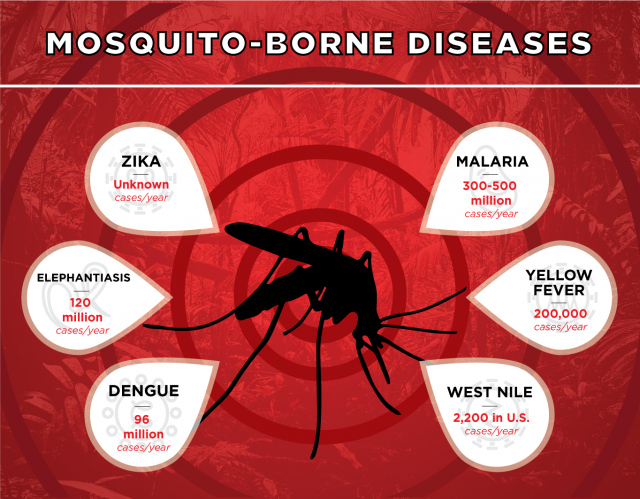There is a long list of mosquito borne diseases worldwide, some do not occur in India except malaria, dengue, Chikungunya, filariasis and Japanese encephalitis, but the chances are high that the remaining one may be contracted while traveling to the affected places.
The brief view of all the mosquito borne diseases is given below –
Chikungunya is transmitted by the two species of mosquito (Aedes.albopictus and A.aegypti):
Chikungunya has been found in Africa, Asia, America, Europe and the Indian subcontinent and transmitted from the infected mosquito bites. These mosquitoes bite during daylight hours and generally at early morning and the late afternoon may be the peak times of their activity. Both species are responsible for large outbreaks of Chikungunya. These mosquitoes are not confined in tropical and sub-tropical area, but also occur in temperate and even cold temperate regions.
Dengue fever is transmitted by the Aedes.aegypti mosquito:
The danger is on the rise dramatically in recent decades worldwide as almost half of the population is at risk of dengue, it is found in tropical and sub-tropical areas and severely affecting Asian and Latin American regions, including India and it is going to be a prime cause of death among elderly and the children in these countries. Europe and Antarctica are the only continents that are still spared for the transmission of dengue fever.
Malaria is transmitted by the Anopheles mosquito:
This mosquito prevails almost all over the world (excluding Antarctica), especially tropical areas and sub-Sahara Africa, even some of the areas after thorough eradication are still constantly at the risk of re-entry of the Anopheles mosquito. They mostly bite after evening and before dawn.
Filariasis or Lymphatic filariasis is transmitted by the different types of mosquitoes such as Culex, Anopheles and Aedes:
The disease is prevalent primarily in tropical and sub-tropical climates, includes Asia, Africa and South America and particularly found in poor countries or poverty affected areas of the world, but not in developing nations.
Japanese Encephalitis (JE) is transmitted by the Culex.tritaeniorhynchus and Culex.vishnui:
JE virus is the most common cause of encephalitis in Asia and the western Pacific area, but it has not been found in Africa, America and Europe. Disease transmission mostly occurs in rural agricultural areas specially rice cultivation and flood irrigation areas. Japanese Encephalitis is mainly a disease of children and infants, but can occur to anyone and the whole year round.
Zika fever is mainly spread via the bite of Aedes type mosquitoes:
Zika is predominately transmitted by the female Aedes aegypti mosquito, which is mostly active in the daytime, at dawn or dusk, till now this viral disease is affecting America (south & central part), Africa, Pacific Island and some part of Asia (Singapore) only.
Yellow fever is transmitted by the Aedes.aegypti mosquito:
Yellow fever virus targets mainly Africa, tropical South and Central America, it is an acute viral disease, infants and children are at highest risk for disease and severe cases have been reported from Africa.
West Nile fever is transmitted by the mosquitoes of the genera Culex:
WNV is mostly found in North America, Europe, Middle East, Asia and Africa. It is transmitted from the birds, through the mosquitoes and horses, humans and other mammals can be infected with this viral disease.
Saint Louis Encephalitis is transmitted by the mosquitoes of the genera Culex:
This disease mainly affect the Gulf coast, Mississippi Valley and United States during the summer season, but the cases can occur throughout the year. Mosquitoes feed on the virus infected birds, then transmits the virus to the animals and the humans.
The Western Equine Encephalomyelitis is transmitted by the mosquitoes of the genera Culex and Culiseta:
This mosquito borne disease is found in some countries of South America and area near the Mississippi river, the disease can cause serious infection in kids but overall mortality is low.
Eastern Equine Encephalitis Virus (EEEV) is transmitted to the humans through the bite of infected mosquitoes (Culiseta.melanura and Cs.orsitans):
Eastern equine encephalitis virus (EEEV) is mostly reported in Massachusetts, Georgia, New Jersey and Florida. EEEV transmission is most common in swampy areas in the Atlantic and Gulf Coast states and the Great Lakes region also.
Venezuelan Equine Encephalitis Virus is transmitted by the species of Culex and Aedes mosquito (Culex.taenopius and Aedes.taeniorhynchus):
It is one of the predominant disease found in South, Central America and Maxico, but Venezuelan equine encephalitis is spreading to the United States too.
La Crosse Encephalitis is transmitted by the Aedes.triseriatus (treehole mosquito) mosquito:
LACV disease is mostly found in mid-Atlantic, Midwestern and Southeastern states such as Virginia, Carolina, Wisconsin and Illinois. Cases reported during late spring and early fall, but can occur in winters too.
It is amazing to know that how miniature mosquitoes carry the life threatening diseases and how they are imposing the biggest challenge to the mankind as they can breed anywhere – from the planter pot to the garbage. We can only keep them away from our family by taking strict measures, usually during the time of monsoon. Mosquitoes do not only make our skin itchy, but also make our life miserable, so we should learn to deal with them timely and in the most appropriate way since it is almost impossible to eradicate them from the planet earth.






























































